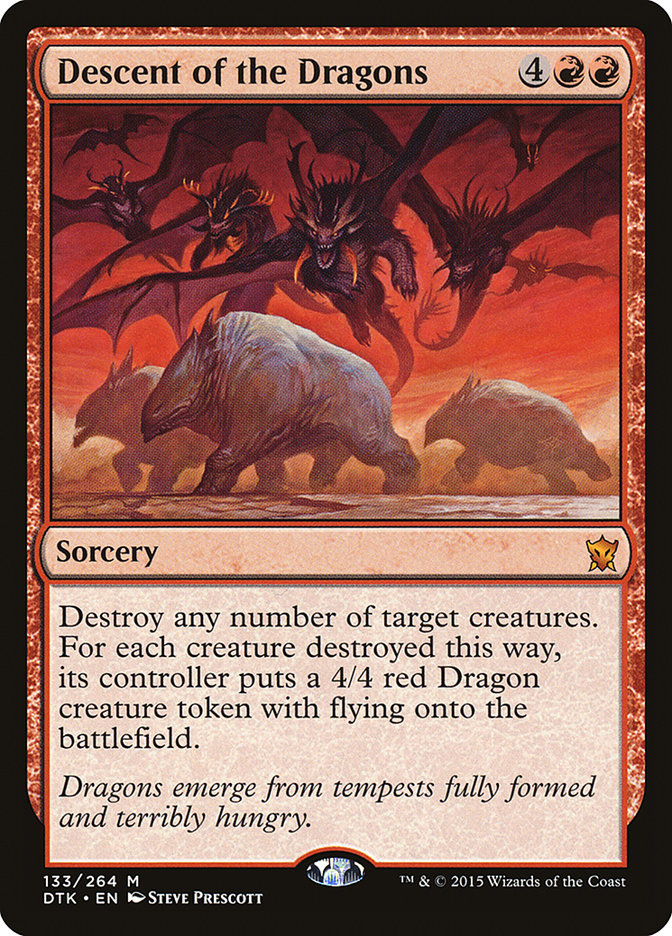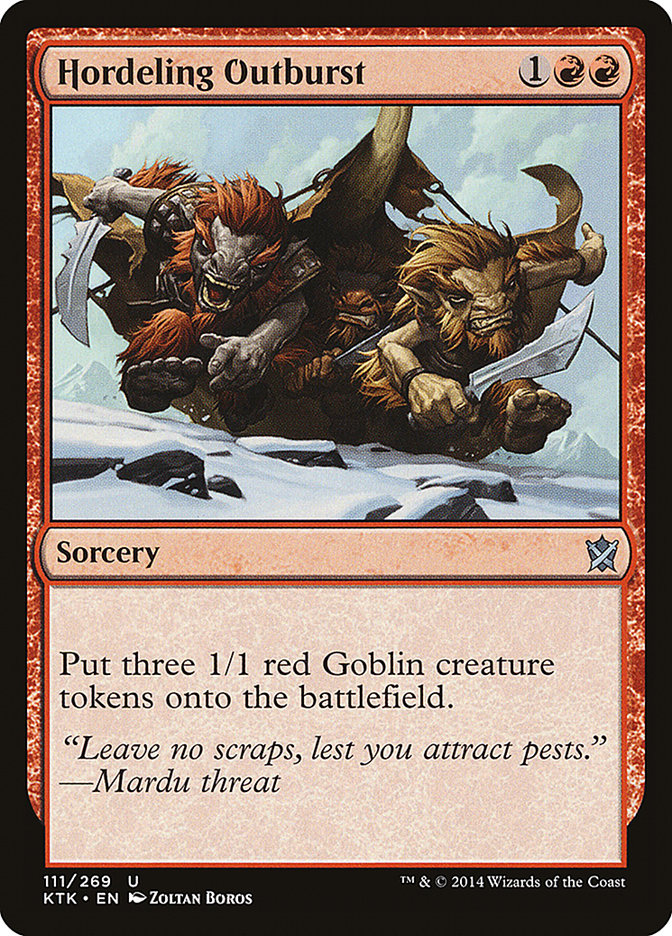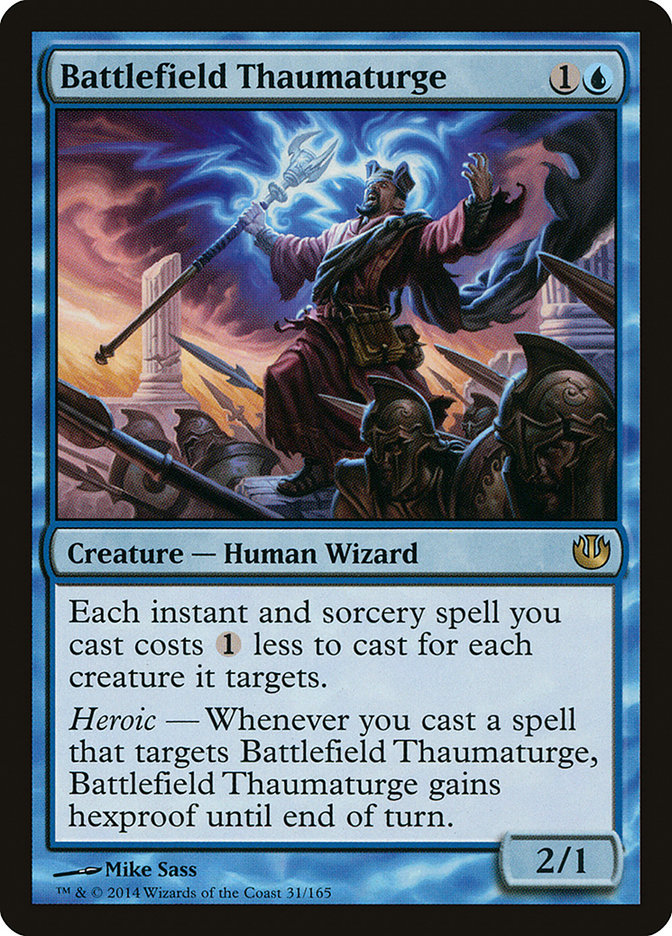What an exciting Pro Tour weekend! Lots of innovation, new cards, and remakes on older strategies made a comeback, and some of the sleeper cards from
Dragons of Tarkir finally woke up and took center stage. This was a Pro Tour I pursued myself, and although I didn’t get to Belgium, three local
Louisvillians did: Levi Basham, Bobby Graves, and Tyler Winn. All of them put up great numbers for a Pro Tour, and Bobby snagged a Top 64 slot. Great job,
guys! Our own StarCityGames.com crew took a whack at it, too, with Bard Narson clinching a Top 16. Mark Nestico, my favorite writer here, got a chance at
the big show, too. Great job, everyone!
As a brewer, watching a Pro Tour can be both exciting and disappointing. On one hand, these are the most tailored decks you’ll find in that season;
hundreds of people each put in hundreds of testing and brewing hours to make sure their list is the one that breaks the format. Rarely does
someone take a stock list and run it as-is, so brewers might see their pet cards come out of the woodwork. On one hand, you could be excited that the card
you’ve been championing is seeing play on such a global stage; on the other hand, if anyone sees you playing it after that event, they’ll think you only
noticed the card after Sam Black, Conley Woods, or Travis Woo jammed it.
However, after sixteen rounds of Standard, this week’s card, a mythic, no less, still didn’t surface in the Belgian brawl.
There wouldn’t really have been a reason for it to show up. It’s a six-mana conditional spell whose predecessors are far more impressive: Entreat the
Angels. Devout Invocation, and Hour of Need are arguably all better because they are more flexible, efficient, and less destructive. However, there are
three cards currently in Standard that help make this card a bit more interesting, and two are well-known.
Yes, Dragon Fodder/Krenko’s Command/Dragon Fodder is back, right along with the red Spectral Procession; both have become staples in Standard thanks to
their efficient production and distribution of power. But the third card that enables this strategy is no stranger to this column, even appearing as
recently as last week. Yep, it’s our Thaumaturge!
Why can’t this guy hang around forever? I love cost reducers, and Battlefield Thaumaturge loves a full board to spread spells far and wide. With Descent of
the Dragons, four targets means you’re paying RR for four 4/4 Dragons, which when backed up with any burn spell or even a couple fetchlands and
Thoughtseizes on the part of your opponent, is a sturdy, lethal amount. Turn 2 Dragon Fodder, turn 3 Hordeling Outburst and attack, turn 4 Battlefield
Thaumaturge and Descent of Dragons your board, and you’ve got six 4/4 dragons breathing fire down your opponent’s neck. Bile Blight won’t save them. Anger
of the Gods is ignored. In fact, unless they use a ramp spell, there are very few ways to deal with such a huge quantity of Dragons that early. Most people
are sticking their one Thunderbreak Regent or Stormbreath Dragon about now, but you’re not messing around. You’ve got the whole gang there for a flyby.
The two colors required to complete this combo should be sufficient to start brewing this up. Red is known for its burn, and instead of aiming at an
opponent’s face or a stubborn creature in the way of combat, it can be used defensively until I can get the whole combo together. Each token producer is
efficient and cheap, meaning I’ll have blue mana up to front a counterspell or other manipulation.
What are we waiting for? Blue and red, here we come!
Creatures (8)
Lands (25)
Spells (27)

This is how I started, but as always, the numbers seemed a bit wrong. It seemed too clunky and uninteractive, and the fetchlands didn’t do much to help me
survive despite building a good delve, so I thinned it out.
Creatures (8)
Lands (26)
Spells (26)

This feels more like a real starting point; let’s take a look!
Creatures
First off, you need a Thaumaturge. In a slower shell like this, you might think that Thaumaturge is too cute and/or unnecessary to the strategy, coming up
too many times as just a 2/1 with few other spells with which it can successfully interact. However, the ability to cast your biggest spell for a third the
cost means you can still do something else; counterspells, burn, and additional options suddenly become available when you convert an army of Goblins into
a fleet of Dragons for so cheap. Even if I’ve got plenty of lands, I’ll still be glad for the Thaumaturge so my shields aren’t completely down for too
long. Chasm Skulker was a bit of a breakthrough as a reasonable, on-theme creature. Brewers have been stepping towards and away from the Squid Horror since
last July, but this list might give it a sliming chance. There are lots of ways to draw in this deck, and if it sticks around long enough, it can fuel a
Descent of the Dragons all by itself. Sometimes the evasive Squid tokens might be preferred. Finally, Jeskai Sage is a nice speedbump for an aggressive
deck, and it has the potential to trade a flimsy burn spell into serious damage. Blocking and casting Wild Slash lets you hit something for four, and
you’re not even down a card. If you kill it to make Dragons appear, you get to replace it, too! It even triggers Chasm Skulker, so curving into that can
feel pretty good, too.
Spells
The eight Goblin-producers are non-negotiable. Both have been big parts of Standard, and Hordeling Outburst especially. The flavor of Dragon Fodder
actually being used as dragon fodder is not lost on me. Wild Slash was always the removal spell of choice over the more conventional Lightning
Strike. Cutting the cost in half made more sense for tight play, and because the deck was particularly soft to quick decks, where I’d only really be
one-for-one’ing them, Wild Slash seemed far superior. It probably wouldn’t go to the face often, so maybe even Magma Spray would be better in a world of
Deathmist Raptor and Hornet Queen. It’s also important to note that you can kill a Goblin token, too, confounding a Bile Blight’s target. Stoke the Flames
is another must-have red spell. It’s also notable as the only other spell Battlefield Thaumaturge helps, and it really does make a difference. If you’re
stuck on two mana, you can cast a Thaumaturge, then a Dragon Fodder and still be able to Stoke the Flames with just the two tokens and the Thaumaturge.
People forget that it reduces the cost, so they might stick a four-drop in the hope that it won’t immediately die. Surprise; this freshly cast Hordeling
Outburst is enough, even when I’m otherwise tapped out!
Two copies of Descent of the Dragons seems correct. With lots of draw and filtering, it won’t be long until you have the one copy you need in hand, and you
never really want two unless, of course, you need vigilance. You can smash with your team, then kill them with Descent of the Dragons and have a new set of
untapped dragons ready to defend. Two Anticipate and two Treasure Cruise seemed like the right balance. You’re bleeding spells left and right, and with the
glut of lands in the deck, you’ll often have plenty of mana to slide in the Anticipate and/or hardcast Treasure Cruise. Anticipate isn’t an awesome spell,
but in a combo deck, I feel like it’s important. It’s an instant Treasure Cruise where you only keep one card. A pair of Dissolves gives me a level of
protection seldom afforded to red decks, and when you’re putting the combo together, Dissolve makes you feel surprisingly safe. Disdainful Stroke was a
concession to top end decks and, because I have no ramp, it could keep me ahead of a Planeswalker, Siege Rhino, or Whip of Erebos. I added a single Outpost
Siege, where either mode could be useful; I can clear my board in combat or through Descent of the Dragons and deal you lots of damage, or I could have an
extra chance to rip burn spells and token producers. Win-win!
Lands
Fetchlands seemed far too painful, so I cut down on them significantly with the option to totally axe them later. 26 lands seems like a lot, but because
you have to be ready to cast a six-drop if things don’t go together perfectly, it only seems fair. Red is definitely the main color, but blue is essential;
this balance of basics felt right, with an extra Evolving Wilds thrown in to add to Treasure Cruise and the fixing potential.
This was still a rough draft, so I sleeved up what I could, proxied the rest, and took it to battle. I played a pickup game against Victor, a pal from my
shop, who’s also got a brewing mindset. Over five games against Jeskai Aggro, I saw that the plan was excellent, but the execution was poor. The deck was
still a bit clunky and underpowered. The lands still seemed wrong, and I was taking damage too quickly across the board. He got me in four out of five
games, but two of my losses were pretty decent fights that, with some deck improvements, I could have gotten out of. He also brought to mind Virulent
Plague as a hard counter for my deck, and although I felt semi-prepared to go over the top with burn spells in that instance, I still felt nervous about
it.
Back to the lab!
Creatures (6)
Lands (25)
Spells (29)
- 4 Dragon Fodder
- 2 Dissolve
- 4 Stoke the Flames
- 1 Obelisk of Urd
- 3 Treasure Cruise
- 4 Hordeling Outburst
- 2 Outpost Siege
- 4 Wild Slash
- 2 Anticipate
- 1 Roast
- 2 Descent of the Dragons
Sideboard

I spruced up the power density of the deck, adding another copy of Outpost Siege and Treasure Cruise while adding a slot for Roast and trimming a land. The
sideboard became more focused, siding into the Swan Song/Searing Blood combo.
I felt really confident that this was a step in the right direction, so I bought the rest of the pieces I needed, slotted 75 real cards, and jammed eight
more test matches.
Most aggro decks were putty in my hands. I beat up an Abzan, Temur, Red, R/W, and Bant Heroic list, with the mono-red deck giving me the most trouble. The
others, though, were easy wins; having four maindeck Wild Slash was excellent in those matchups, and you could easily get on the other side of any deck by
using two at once, which is more efficient mana-wise than Stoke the Flames if you’re behind. Chasm Skulker even did great; they either aimed their burn at
my face or at the currently irrelevant 1/1, and they often (incorrectly) chose my face. Descent of the Dragons was the game winner in most instances, but
occasionally, an army of Goblins backed up with burn was enough to get the concession.
I played against the new G/R Aggro list flounced around by our own Chris VanMeter and other prominent pros, and while Atarka’s Command is a heck of a card,
it can be played around enough to get the job done, and I clinched a nail-biting 3-2 match. It is important to note that all these matches were
pre-sideboard, so it had clout against lots of decks in the first game.
I struggled against U/B Control and G/B Constellation; a friend had been working on a G/B brew and, when pitted against my fresh brew, it crumbled. Whip is
unbeatable, with Hornet Queen being a hard stop for anything I’m doing. U/B was probably winnable, but the version I played still had Pearl Lake Ancient,
and returning three Radiant Fountain every three turns and having counterspells and Hero’s Downfall for the sparse Dragon I made kept me down, even when
I’d get an early lead. It’s possible that the deck just doens’t have game against those strategies, but I did try sideboarding against these two, and it really helped. Swan Song and Keranos, in particular, were outstanding, hard-to-target successes. Outpost Siege was also excellent, and there might
be room for three, or even four, in the maindeck.
Despite these tough matches, this is a successful brew. If you’re struggling against aggro decks in your local metagame, give this a shot. I bet you can
make some improvements, too, to bolster the deck even more.
Maybe a third color is the right path? It’s possible that green, with its bevy of mana creatures, might provide the perfect setup for a big
Descent of the Dragons?
Creatures (24)
- 4 Hornet Queen
- 4 Elvish Mystic
- 4 Sylvan Caryatid
- 4 Courser of Kruphix
- 4 Battlefield Thaumaturge
- 4 Rattleclaw Mystic
Planeswalkers (2)
Lands (24)
Spells (10)

There’s definitely something here and in the Izzet-hued version, too. I’m gonna keep working on it, so maybe there’ll be something to report before long.
What about you? Maybe a Grixis build is correct, eschewing the burn for hard removal and discard, or Jeskai, with strong white applications like Elspeth,
Sun’s Champion? The sky’s the limit when you’re talking Dragons!




